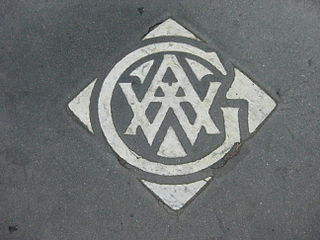Related Research Articles

Harry Seidler was an Austrian-born Australian architect who is considered to be one of the leading exponents of Modernism's methodology in Australia and the first architect to fully express the principles of the Bauhaus in Australia.

Josef Albers was a German-born American artist and educator who is considered one of the most influential 20th-century art teachers in the United States. Born in 1888 in Bottrop, Westphalia, Germany, into a Roman Catholic family with a background in craftsmanship, Albers received practical training in diverse skills like engraving glass, plumbing, and wiring during his childhood. He later worked as a schoolteacher from 1908 to 1913 and received his first public commission in 1918 and moved to Munich in 1919.

The Texas Ranger Division, commonly called the Texas Rangers and also known as Diablos Tejanos, is an investigative law enforcement agency with statewide jurisdiction in the U.S. state of Texas. It is based in the capital city Austin. In the time since its creation, the Texas Rangers have investigated crimes ranging from murder to political corruption, acted in riot control and as detectives, protected the governor of Texas, tracked down fugitives, served as a security force at important state locations, including the Alamo, and functioned as a paramilitary force at the service of both the Republic (1836–1846) and the State of Texas.

The Art Workers' Guild is an organisation established in 1884 by a group of British painters, sculptors, architects, and designers associated with the ideas of William Morris and the Arts and Crafts movement. The guild promoted the 'unity of all the arts', denying the distinction between fine and applied art. It opposed the professionalisation of architecture – which was promoted by the Royal Institute of British Architects at this time – in the belief that this would inhibit design. In his 1998 book, Introduction to Victorian Style, University of Brighton's David Crowley stated the guild was "the conscientious core of the Arts and Crafts Movement".

Francis Augustus Hamer was an American lawman and Texas Ranger who led the 1934 posse that tracked down and killed criminals Bonnie Parker and Clyde Barrow. Renowned for his toughness, marksmanship, and investigative skill, he acquired status in the Southwest as the archetypal Texas Ranger. He was inducted into the Texas Ranger Hall of Fame. His professional record and reputation are controversial, particularly with regard to his willingness to use extrajudicial killing even in an increasingly modernized society.
Harwell Hamilton Harris, was a modernist American architect, noted for his work in Southern California that assimilated European and American influences. He lived and worked in North Carolina from 1962 until his death in 1990.

The Yale School of Art is the art school of Yale University. Founded in 1869 as the first professional fine arts school in the United States, it grants Masters of Fine Arts degrees to students completing a two-year course in graphic design, painting/printmaking, photography, or sculpture.
Bernhard Hoesli (1923–1984) was a Swiss architect and collage artist.

John Fanz Staub was a residential architect who designed numerous traditionally-styled homes and mansions, mostly in Houston, Texas, from the 1920s to 1960s.

The University of Texas at Austin School of Architecture (UTSOA) is a college within The University of Texas at Austin, with its major facilities located on the main university campus in Austin, Texas, United States.
Atlee Bernard Ayres was an American architect. He lived in central Texas.
Robert Mosher was an American architect who operated primarily in Southern California. Mosher was a Taliesin apprentice of Frank Lloyd Wright, and a pioneer of the post-war modernist architecture movement in San Diego. He is best known for designing the San Diego-Coronado Bridge, and the University of California, San Diego's John Muir College.
Michael Benedikt is an architect, urbanist, and academic. He is noted for formalizing and promoting the geographical concept called isovist. Benedikt is also an advocate of the interior design concept called "interiorist" practice.
Kent C. Bloomer was an American sculptor, professor and author who is a well known proponent and creator of architectural ornament. He taught classes on ornament at the Yale School of Architecture for over forty years, and many of his public works of ornament have become well known landmarks. He wrote several books and articles on visual perception and architectural ornament, including the principal authorship, with Charles Moore, of “Body, Memory and Architecture,” 1977.
From 1961–1967, in the U.S., the School Construction Systems Development (SCSD) project created an innovative, flexible, and prefabricated architectural building system that ignited an international interest in systems-based architecture. The project emerged in response to the post-WWII baby boom, the mainstreaming of progressive education, the industrialization of building materials, and a nationwide search to build schools faster and cheaper. In 1961 Governor Nelson Rockefeller of New York proposed the use of stock plans. In response, the Architectural Forum and the Ford Foundation's Educational Facilities Laboratories (EFL) sponsored a conference of leading school administrators, architects, manufacturing executives, and engineers to devise alternative solutions.
Louise Harpman is a New York–based architect, urban designer, teacher, and author. She is a Professor of Architecture, Urban Design, and Sustainability at New York University’s Gallatin School of Individualized Study and the founding principal of the design and research practice, Louise Harpman__PROJECTS. She was previously a founder and principal of the architecture and design firm, Specht Harpman.

Vincent "Vince" Richards Lee, now retired, has served as a Marine Corps officer, founder and chief instructor of his own mountaineering school, western residential architect, Andean explorer, scholar of megalithic monuments, avocational Southwest archaeologist, and author of several books on many of those subjects.

Eugene Campbell Barker was an American historian at the University of Texas, the managing director of the Texas State Historical Association, and the editor of the Southwestern Historical Quarterly. He chaired the history department while soliciting gifts to the university, which he used to build a collection of archives and artifacts. In 1950, the university dedicated the Eugene C. Barker History Center as a repository for his collections. These collections are an important part of the Dolph Briscoe Center for American History at the University of Texas.

Van Dorn Hooker was an American architect and the University Architect for the University of New Mexico from 1963 to 1987.

Irwin Rubin was an American artist and educator known for his colorfully painted wood constructions.
References
- "History of the School". University of Texas at Austin School of Architecture . Archived from the original on 2006-01-29.
- Caragonne, Alexander (1995). The Texas Rangers: Notes from an Architectural Underground. Cambridge, MA: MIT Press. ISBN 9780262032186. OCLC 30778192.
- Germany, Lisa (1991). Harwell Hamilton Harris. Austin: University of Texas Press. pp. 139–156. ISBN 9780292730434. OCLC 22209657.